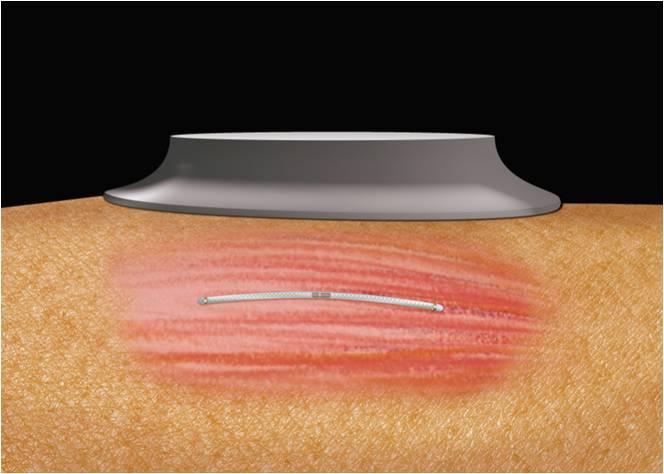The human body as an electrical conductor, a new method of wireless power transfer

Image credits: BERG-UPF
The project Electronic AXONs: wireless microstimulators based on electronic rectification of epidermically applied currents (eAXON, 2017-2022), funded by a European Research Council (ERC) Consolidator Grant awarded to Antoni Ivorra, head of the Biomedical Electronics Research Group (BERG) of the Department of Information and Communication Technologies (DTIC) at UPF principally aims to “develop very thin, flexible, injectable microstimulators to restore movement in paralysis”, says Ivorra, principal investigator of the project.
A secondary goal of this project is to illustrate how volume conduction (also known as galvanic coupling) can be used to transfer power wirelessly to electronic implants. Volume conduction is considered an alternative to batteries or wireless power transfer based on inductive coupling since these two supply methods imply that implants must be relatively large to accommodate the components needed to obtain the energy required for operation.
One of the main parameters of interest to know if a technology has the potential to supply implants is to determine the maximum power implants can receive by using the proposed method.
Thus, the main goal of the study published in the journal IEEE Access is to use equations to determine the maximum power an implant can receive by means of volume conduction when the currents applied are safe according to the electrical safety standards.
Its authors are Marc Tudela, Laura Becerra-Fajardo, Aracelys García-Moreno, Jesus Minguillon and Antoni Ivorra.
“Today, the main element that hinders the development of minimally invasive implants is the way they get power. In this regard, we believe that volume conduction has the potential to solve this problem. Volume conduction allows us to develop thread-like devices that can be implanted by injection”, Tudela explains.
Wireless Power Transfer (WPT)
The method of wireless energy transfer via volume conduction consists of using the body's own tissues as a channel for transferring electrical power. Using an external system, electrical currents are delivered through the human body and these currents flow through tissues and a small amount is drawn by the implants.
This is how the implants get the energy necessary for operating. The innovative aspect of the authors' approach is the thread-like form of the implants, which allows them to be injected without surgery, and the use of high frequency currents (> 5 MHz) applied in bursts, rendering them completely harmless and imperceptible.
To produce power to implants in the region of milliwatts, the authors propose applying currents with magnitudes of the order of a few amperes for which the external system must generate tensions of around a few hundred volts.
These magnitudes would be most harmful if it they corresponded to alternating currents of a frequency like that of the grid (50 Hz). This completely avoids using higher frequencies. Specifically, the authors propose the use of alternating currents with a frequency of greater than 5 MHz.
The authors of the study published in IEEE Access obtained mathematical models that allowed them to determine the maximum local power that can be obtained by an implant using volume conduction according to the size of the implant, its electronic charge and the properties of the tissue where it will be placed.
Finally, they validated these models in vitro using a saline solution that simulates the electrical properties of human tissue and obtained a good correlation between experimental and analytical results.
Devices that can be easily implanted by injection
Thus, the study results show that by applying high frequency electrical currents in a burst -harmless for the human body and that meet the main international safety standards- can yield powers of greater than 1 mW in very thin (section less than 1 mm), short (< 15 mm) implants. These devices can be easily implanted using a percutaneous procedure similar to an injection.
“Another interesting result we have obtained is that the application of high frequency electrical currents in the form of bursts, rather than continuously, enables maximizing the power obtained in the implants”, Tudela comments. And the researcher adds, “our results indicate that an implant with a section of only one millimetre and a length of about one centimetre could get 100 times the power currently required by a pacemaker”.
Media Contact
All latest news from the category: Medical Engineering
The development of medical equipment, products and technical procedures is characterized by high research and development costs in a variety of fields related to the study of human medicine.
innovations-report provides informative and stimulating reports and articles on topics ranging from imaging processes, cell and tissue techniques, optical techniques, implants, orthopedic aids, clinical and medical office equipment, dialysis systems and x-ray/radiation monitoring devices to endoscopy, ultrasound, surgical techniques, and dental materials.
Newest articles

A ‘language’ for ML models to predict nanopore properties
A large number of 2D materials like graphene can have nanopores – small holes formed by missing atoms through which foreign substances can pass. The properties of these nanopores dictate many…

Clinically validated, wearable ultrasound patch
… for continuous blood pressure monitoring. A team of researchers at the University of California San Diego has developed a new and improved wearable ultrasound patch for continuous and noninvasive…

A new puzzle piece for string theory research
Dr. Ksenia Fedosova from the Cluster of Excellence Mathematics Münster, along with an international research team, has proven a conjecture in string theory that physicists had proposed regarding certain equations….



